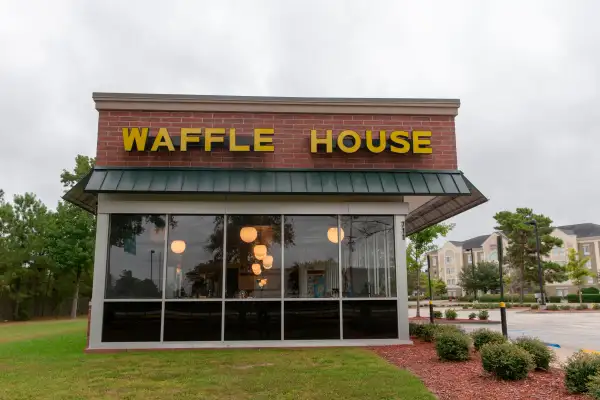Waffle House Stays Open and Slashes Prices During Hurricanes Like Florence. Here’s How It Helps Affected Communities

Waffle House is a port in a literal storm. The 24-hour, diner-style restaurant chain, which is based in the South and beloved all over the region for its breakfast staples, is known for rarely shutting its doors. It frequently stays open even at locations in the path of a storm or hurricane like Florence.
That’s part of why the Federal Emergency Management Agency, or FEMA, looks to Waffle House to help it gauge how storms are impacting local areas. Its color-coded Waffle House Index monitors when locations are open, closed, or offering a limited menu.
The restaurant chain works with government agencies including FEMA, according to Waffle House spokesperson Pat Warner. The index, which started in 2004, allows officials to “kind of see how a community is coming back,” Warner says. “They help us by providing power and highway info, so it’s really a partnership.” While many other companies work with FEMA, “we seem to get the spotlight” in the media, he adds.
Waffle House remained strong in the face of Hurricane Florence, which made landfall on the North Carolina coast on Friday and was downgraded to a tropical storm. So far, it’s killed at least four people, according to authorities.
“We’re doing pretty well, though it’s hard to get a good assessment right now,” Warner said when talking to Money Friday evening of how Waffle House is faring. “A lot of our restaurants are open. We have some closing in Wilmington,” on the coast.
The company has developed a hurricane preparation procedure over decades, and even has a Waffle House Storm Center.
“We were tracking the storm all last week. On Monday, we started putting the wheels in motion on three main things: people, power, and food,” Warner says.
Waffle House brings in over 100 people from outside affected markets, known as “jump teams,” to help local staff ride out the storm while they’re focused on loved ones. It supplies power generators and backup food supplies as necessary and once transportation is safe. The leadership also makes its way to the disaster zone: CEO Walt Ehmer was recently in Myrtle Beach, S.C. Executives help make decisions about resources and appropriate responses. They communicate and coordinate with employees back in Georgia headquarters.
Waffle House is more than a spot for a hot meal in these times, too. “We’re that gathering place where people get together to talk about local happenings,” Warner says. “After the storm, we feel like we need to be there. It brings the community back faster.” The overall objective is to return to “normalcy,” as he puts it.
Restaurants generally see first responders and power company employees show up earliest in the wake of a storm.
“You’ll start to see folks getting out more, back at Waffle House to check in on everybody, make sure everybody’s okay, get a good meal,” Warner says. If power is out and Waffle House has a generator, it serves as a hub for people to charge their dead cellphones. And it’s a way for associates to make money when they otherwise wouldn’t be during a critical time. “That sense of community drives us through.”
As for the food, Waffle House has four secret limited menus in place for disasters, utilized based on the situation: a no-power menu, a no-water menu, and two limited menus with a wider range of options that are deployed depending on customer volume.
“With no no electricity, you’re not going to get waffles. We’ll have canned drinks but no fountain drinks. We’ll have a lot of things you can cook on the grill: hash browns, eggs, sausage. Cheeseburgers are big on the no-power menu,” Warner says. (The griddle runs on gas, not electricity.) With no water, waffles are again out, since the equipment requires a lot of cleaning.
Waffle House is famous for its hash browns available in all kinds of topping combinations—”smothered” with grilled onions, “covered” in melted cheese, loaded “all the way.” These humble, inexpensive, yet excellent breakfast dishes, available around the clock, offer a comforting and accessible meal in the middle of a difficult period.
And what’s better for those hunkered down during Florence, Waffle House also cuts its prices during emergencies. Bills are calculated with the lowest tax rate in the local market, and then rounded down from there to the nearest dollar. “Some people might not have credit cards,” Warner explains of the policy. “It makes everything more affordable and easy for everyone.”